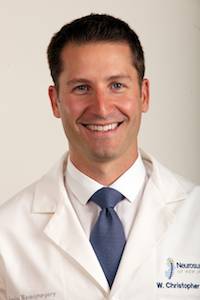ESPN reported last week that Ohio State’s head football coach, Urban Meyer, recently underwent brain surgery to drain an arachnoid cyst. The cyst was originally discovered in 1998, but with the recent onset of persistent headaches, Meyer was sent for further testing. Images of his brain revealed that the cyst was enlarged and needed to be drained. The news had a few people asking our neurosurgeons for more detail about the condition and surgical procedure.
Though none of our surgeons took part in any aspect of the coach’s diagnosis or treatment, they regularly see this condition in their neurosurgical practice. Dr. William Christopher Fox, a neurosurgeon who specializes in the treatment of athletes as well as military personnel, had this to say:
“An arachnoid cyst is a fluid filled sac located between the brain and the arachnoid membrane, the middle of three membranes that cover and protect the brain.
Arachnoid cysts are congenital (or present at birth) and typically asymptomatic. They often go undiscovered, or when they are found it is incidental and happens when the patient is being evaluated for another problem. For these patients, no treatment is needed other than a follow-up imaging study to make sure the cyst hasn’t changed.
In some patients, however, the cyst may place pressure on the surrounding brain and cause headaches or other symptoms. In these patients, surgical drainage of the cyst may be necessary. Draining the cyst can be done using a traditional open brain procedure or a minimally invasive procedure using an endoscope. Either way, most patients do quite well.”

New Jersey Neurosurgeon, Dr. William Christopher Fox
Coach Meyer appears to be having a quick recovery. He is reportedly back at work coaching his team’s spring practice. We wish him the very best!
Dr. Fox has a thriving practice in our Ridgedwood, New Jersey office where his sees patients with a large variety of neurosurgical issues. In addition to treating athletes he also specializes in the treatment of neuro-vascular disease using endovascular and traditional surgical methods as well as minimally invasive approaches to the spine.
To learn more about Dr. William Christopher Fox, see his bio page here.


